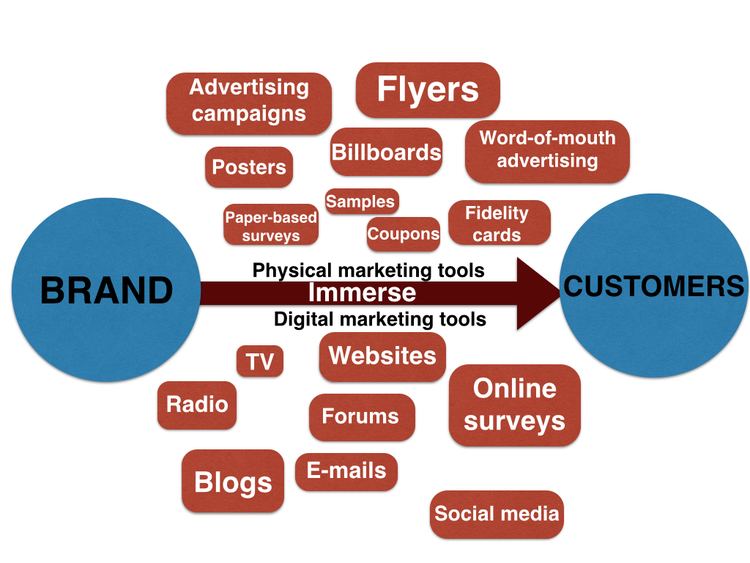 | ||
The term immersion marketing or immersive marketing includes traditional advertising, public relations, word-of-mouth advertising, digital marketing, samples, coupons, retail partnerships and other ways of surrounding the consumer with a consistent message about a brand. In essence, immersion marketing envelopes a brand or product or company issue so that the marketing, advertising, and public relations departments or representatives work holistically towards delivering the same brand message across multiple distribution channels. Unlike "Shotgun marketing"(communicate the message to anyone who listens), immersive marketing is cheaper and more effective, focusing directly on the customer's needs.
Contents
- Approach to customers
- Relationships with customers
- Focus on the message
- Immersive market research
- Ethnography
- Netnography
- Participant reporting
- Physical tools
- Digital tools
- Example of immersion marketing
- References
Immersion marketing or immersive marketing succeeds engagement marketing, the difference being a huge emphasis on enveloping consumers in the brand. Therefore, Shar Van Boskirk of Forrester Research characterizes it as "a cohesive and all-encompassing experience across any channel where the customer is." .
Event Magazine listed immersion marketing as one of its top trends advertisers must use in 2015.
Approach to customers
In comparison to traditional forms of marketing, the immersive marketing methods are distinctly passive. The customer is invited in a friendly environment (e.g. retail store) instead of being aggressively forced to do so. The idea is to encourage customers to engage in a two-way interaction with the brand. Therefore, instead of being passive aggressive, the marketers must be aggressively passive in their approach in order to succeed attracting consumers.
According to TBA’s managing director, Guy Horner, the consumers tend to prefer this type of approach "It comes down to creating engaging brand experiences that connect with consumers. The growth area is engagement and immersion, bringing the brand world to life," he says.
Relationships with customers
A good relationship must be built between consumers and marketers, that is why they need to interact before, during and after the sale. Nowadays, a lot of brands are focusing only on the pre-sale part, which is not such a good idea, because after the sale is over, the customer will be on its own. Lately, the customers tend to care more about the post-sale part, in which they can help brand with feedbacks and, reversely, the brand can help them if they encounter any problem.
Therefore, the other parts of the company need to make a contribution every single marketing campaign and to collaborate between them in order to satisfy the customers and to play a bigger role in the customer experience.
Focus on the message
Immersion marketing is about delivering a message on various media channels, but in order to be taken in consideration, the message have to be consistent and the same among all the channels. The message must be as simple as possible and it should fill the needs of the market which is addressed to. Even if the message is delivered through radio, television, social media, flyers, coupons, samples, posters or phone calls, the consumers should get, subconsciously, the same idea from it. In other words, all of the exposures should be retrieved as one total experience.
When creating a message that will be delivered on a wide range of marketing channels, the brand should think of two aspects:
Immersive market research
Immersive market research techniques help the companies understand the behaviors and perceptions at the time the consumers face them. The companies use them in the following circumstances:
Ethnography
Employees conducting this type of research should spend time with customers, being immersed in their daily life.
Netnography
Netnography is the same thing as etnography, but it is conducted online. It analyses the consumer’s life through blogs, forums, social media and other online contents.
Participant reporting
The alternative to both ethnography and netnography is to ask customers to conduct researches on the company’s behalf. This can be done traditionally, by completing a diary, or it may be used the TROI(Touchpoint Return On Investment) method, in which the customers notify the company whenever they encounter the brand. The point is to study the customer’s experience without the work of a researcher.
Physical tools
Digital tools
The combination of the physical and digital tools results in "Phygital". This morph word suggests that the success in the future of marketing depends on creating an ecosystem between the company and its customers that involves both the digital and physical space.
Example of immersion marketing
An immersion marketing campaign should have a strong message exposed on various marketing channels across a certain place or target. Therefore, let's choose the motto of the brand as message, a residential complex for location and the residents as targeted customers. In this case, the marketing actions will be the following:
This type of brand awareness will be much more effective than the traditional methods. Therefore, the company will benefit from major exposure to the residents.
